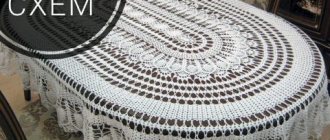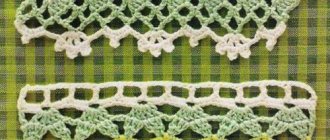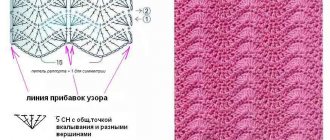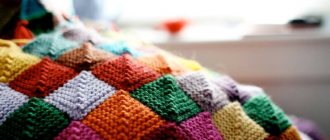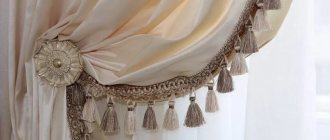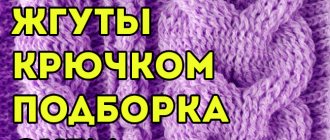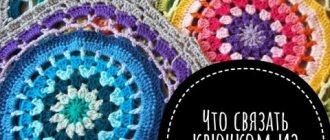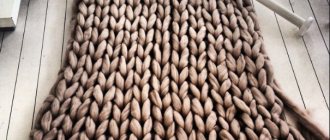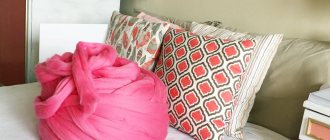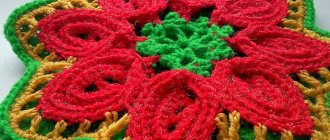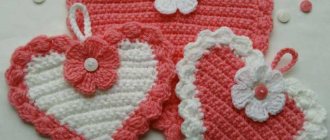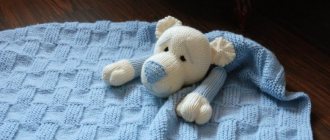Author: School of creativity “Vklubochke”
So often people have the desire to wrap themselves in a soft blanket on a cold day that will warm them up. Knitted blankets are especially popular. They have wide use cases.
This thing can become both a stylish interior detail and a cozy blanket for a child. Or a good gift. Today there are many different options, from simple to more complex, which allow you to make your own blanket even for those who are just starting out.
- To make it you will need yarn. Its selection in most cases depends on the assignment for the finished work. For example, thanks to woolen threads or using acrylic with wool, you can create a warm blanket for adults.
- If the product is intended for a child, then it is necessary to purchase threads with the inscription “children’s”. Most often, they should include acrylic with cotton and bamboo. These threads are considered to be mixed. But you don’t have to use new skeins, using leftovers that you have left at home.
It is based on the thickness of the thread that the hook or knitting needles are selected. It is worth choosing special knitting needles on a fishing line (circular) if you plan to make the intended blanket in a whole large fabric.
It is worth remembering that the fishing line must be the same diameter as the knitting needles. In further work, this will ensure free movement of the loops.
Easy crochet blanket
For this crocheted blanket, you can take different threads that you have at home. You can also choose the color according to your preferences.
In this description of knitting a blanket, the following abbreviations will be used:
- Air loop - VP.;
- Double crochet - Dc;
- Single crochet - sc;
- Connecting post – conn. Art.;
- Indication of a certain number of turns – *
- Indication of a certain number of loops – ()
- Lifting loop – PP.
The size of the product already made according to this blanket knitting pattern will be approximately 100 x 112 cm.
It is important to note that absolutely all stitches will be crocheted through both loops and the exact dimensions of the blanket depend on whether the selected product will be crocheted looser or tighter.
To start the task you need to tie the base:
- The beginning consists of 130 VPs;
- The first row should consist of the fourth loop of two dc from the selected hook, *then you need to skip exactly two loops and add three dc**. Repeat these actions from * to ** and until the very end. Rotate (129);
- In the second row there are 3 VPs, *3 Dcs go between the next groups of 3-Dcs from the previous row**. Repeat from * to ** until the very end. Next, make one DC in the PP followed by a turn (129);
- In the third row, you need to perform 3 VPs, after 2 CCHs in the space between the first CCH and the third CCH of the group from the previous row. Next *3 Dcs in the space between adjacent groups of 3-Dcs from the previous row**. Repeat from * to ** and to the end of the row, also perform 3 DC in the space between adjacent 3-DC groups from the previous row**. Repeat from * to ** and to the end of the row, also making 3 DC in the space between the last 3-DC groups and PP Turn (129);
- From 4 to 71 you need to repeat rows 2-3;
- On row 72, repeat the second.
The next step is to add trim.
- You need to knit a light or any completely different color buckle with the connection. Art. in the last stitch of row 72.
- Then weave the RLS evenly, namely around the entire perimeter, ending with an invisible connection.
To be completely sure, you should watch a video of knitting blankets while working. This will increase the chances of beginners knitting the desired blanket without problems.
Memo to the beginning master
Crochet blankets (knitting patterns for blankets and descriptions are simple and clear) can become a stylish element of room decor, a cozy addition to your favorite chair or a warm gift for a loved one. You just need to learn how to easily select the required hook size for a certain type of thread, for this we advise you to save this reminder:
| Hook number | For which threads |
| 0.6 mm - 1.0 mm | thin cotton threads |
| 2.00 mm - 3.5 mm | medium thickness yarn |
| 4.00 mm - 5.00 mm | medium thickness yarn with double thread |
| 5.50 mm – 6.00 mm | double fluffy thread |
Blanket for a child
To knit a baby blanket, which will be approximately 70 by 90 centimeters in size, you need to take 400 grams of acrylic or “baby” wool and a hook number 6. The blanket is knitted with only two threads.
This scheme is designed specifically for an even number of loops. And if you want, change the sizes by taking and increasing their number. But it should be remembered that the number of loops must be a multiple of two.
- At the very beginning of the knitting process, you need to pull out the thread from the middle of two balls, then type a chain of VP equal to exactly 75 centimeters.
- The next step is to make one ch for lifting, and then knit sc and 2 ch, turning the knitting. As the process progresses, the length may change slightly, because the columns themselves take up much more space than the VP.
- Next, having skipped one loop, you need to tie the RLS, VP into the second and then through one RLS loop. Those RLS and VP that pass over the skipped loop must alternate. You need to knit the last loop of the RLS, where then there are two VPs for lifting, as well as turning the future blanket.
- The entire fourth and all subsequent rows must be knitted with RLS and VP with a certain offset by only one loop.
- The desired pattern will appear in about 10 centimeters. To complete the work on the blanket, you need to sc in each VP and column.
To be confident in your actions, you can compare your product with diagrams or a photo of a knitted blanket.
How to decide on the size
When you knit a product yourself, we are not talking about the standards established by GOST. By and large, you can knit a blanket of any size and volume. If you simply have no idea what parameters such a product should have, here are some approximate sizes:
- Blanket for the stroller for the little ones 80x100 cm.
- In a crib for a newborn 80x120 cm.
- For discharge from the maternity hospital: 90x90 cm, 100x120 cm, but most often a blanket measuring 80x100 cm is knitted.
- Warm blanket for walking with your baby in late autumn and winter, 90x120 cm.
- For a child aged 3-5 years 100x140 cm.
The advantage of a blanket knitted by yourself is that you can choose the size, color and threads for knitting yourself.
Thick plaid
It is from merino itself that in most cases a thick blanket is knitted, which has gained popularity and become everyone’s favorite. It will be one of the best acquisitions for your home.
It can be knitted either using combed tape or conjugated fibers.
Combed tape is especially popular when choosing, but things made with your own labor from unprocessed materials also have their disadvantages:
- When working with tape, there is a fairly high probability that it will break due to the low strength of the raw material;
- The finished product may be prone to various types of deformation;
- These items cannot be washed.
Therefore, merino thread is much better. This material will not break off over time, will not stretch, will not split into fibers and will not lose its shape.
A merino blanket will be smooth to the touch, very soft and quite warm.
Unfortunately, ordinary hooks cannot be used, but improvised means can come to the rescue: tightly rolled papers in rolls, tied with tape, or plastic tubes that have a cone-shaped top. Their circumference can reach more than 20 cm.
It is important to know that the thicker the thread, the larger the diameter. Also, large knitting needles will definitely be needed to use. The fabric comes out frequently, due to the crochet work. This is useful for different types of bedding and carpets. And they make blankets much softer.
General recommendations
To knit a blanket, it is often recommended to buy acrylic threads or combine it with cotton or wool.
Then the blanket will come out tender, warm, soft to the touch and will not prick, as usually happens with pure wool.
- It is difficult to determine the size of threads, so the approximate size is 300 m in 100 grams. It can be even thicker.
- It’s also difficult to accurately determine their consumption, but if you look at it roughly, it takes 700–1000 grams for a meter-long blanket, and up to two kilograms for a large one.
- You should choose a hook depending on the thickness of the purchased thread.
- Blankets are divided into those that need to be knitted from separately knitted pieces and those that are initially knitted as a whole fabric.
- In order for the edges to be smooth and the appearance to be more neat, then the knitted blanket should be tied around the entire perimeter with two or three rows of sc.
You can tie the following types of borders:
- Simple with toes;
- With knitted pompoms;
- Mesh.
Beautiful do-it-yourself openwork blanket made from motifs for a baby
We will need:
- stocks of leftover yarn (100% acrylic, 50 grams per 125 meters) - 4 skeins of blue color. (color A) and 3 skeins of white color. (color B);
- cr. No. 5.5.
Size: 63.5 x 89 cm.
Knitting density: 1 of the motifs = 12.5 x 12.5 cm.
Description
Patterns
With thread A we knit 4 sts. p., we connect the work in a circle. 1 p.: 3 v. p. (= 1st s. with n.), 2 s. s n. in a circle, 2 in. p., (3 s. n. in a circle, 2 v. p.) x 3, ss.. Cut thread A. 2 r.: connect thread B into an arch, 3 v. p., (2 s.s.n., 2 v.p., 3 s.s.n.) in this arch, 1st century. n., * (3 s.s.n., 2 v.p., 3 s.n.) in next. arc, 1st century p., p. from * x 2, ss.. Cut thread B. 3 rows: connect. n. And in the arch, 3rd century. p., (2 s. with n., 2 v. p., 3 s. with n.) in this arch, 1 v. p., *3 s. s n. in the next arc, 1st century p., (3 s. with n., 2 v. p., 3 s. with n.) in the next. arc, 1st century p., p. from * x 2.3 s. s n. in the next arc, ss.. Cut thread A. 4 rows: connect. n. In the arc, 3 c. p., (2 s. from n., 2 v. p., 3 s. from n.) into this arch, 1 v. n., *(3 s.n. in the next arch, 1 v.p.) x 2, (3 s.n., 2 v.p., 3 s.n.) in the next. Ar., 1st century p., from * x 2, (3 s. with n. in next ar.) x 2, ss.. Cut the thread B. 5 r: connect. n. In the Ar., 3rd century. p., (2 s. with n., 2 v. p., 3 s. with n.) in this arch., 1st c. p., *(3 s. with n. in the next ar., 1 v. p.) x 3, (3 s. with n., 2 v. p., 3 s. with n.) in the next. Ar., 1st century p., p. from * x 2, (3 s. with n. in the next ar.) x 3, ss. Let's finish the job.
Blanket
We make 35 of these motifs, alternating the color of the thread in each row, and then very carefully combine them into one solid fabric of 5 x 7 motifs.
Harness
With PM n. And we tie the product around with the help of. without n.. An openwork blanket will decorate not only your baby’s stroller, but also the sofa cushions in your home
Photo of a blanket crochet pattern
+1
Yarn selection
The first step is to select threads for the blanket. Craftswomen advise buying acrylic threads that contain wool or cotton. This material will make a neat, warm cape, it will be soft and pleasant to the body. For children, they are made from a special mixed yarn consisting of acrylic, cotton and bamboo.
The blanket is also crocheted from thick yarn; some combine the remains of skeins of different colors. It is difficult to determine by eye how much material will be needed to create it.
For example, a meter-long crocheted blanket will cost approximately 700 to 1000 g. If its size is larger, then about 2 kg.
Knitted blanket for the sofa
This blanket is also knitted in squares, very beautiful, and has long aroused great interest among needlewomen.
The leaf pattern uses embossed columns, which look very impressive, the center and diagonal braids are made of convex cones; they can be knitted either from several columns knitted together or with “popcorn”. We tried both options, it turns out good either way.
I answer a question that is sometimes asked: these convex bumps do not interfere with sitting at all)).
For one square (its side is 27 cm) when knitting from Caucasian yarn, it took me about 80 grams.
We have a separate post dedicated to this bedspread, which contains all the diagrams, description, master class and video.
Simple patterns
In magazines you can often see unusual, but uncomplicated new items that combine simplicity and beautiful crochet motifs. A hand-made, large-knit blanket will be an excellent addition to a living room, bedroom or nursery. Various techniques are used to create ornaments, for example, Tunisian crochet.
Wool blanket for winter
Currently, voluminous wool blankets, crocheted or knitted, are very popular, for the production of which the thickest yarn from 100 percent merino is chosen. Such products turn out to be very warm, soft and not at all heavy, despite their impressive dimensions. It is noteworthy that they can serve as an elegant bedspread. As a clear example, we can cite modern photo studios, in which similar accessories are often found that serve as a backdrop for photographed couples in love or even for newborn babies.
Knitting such a blanket is so simple that, if desired, even the most inexperienced needlewoman can cope with the task. You will also be pleased with the speed of the process of making bedspreads from the thickest yarn, because if you get your hands full, you can finish it in one day.
Despite this, the cost of such handmade items is very high, so it is quite possible to turn your favorite hobby into a profitable business, successfully combining business with pleasure.
Light bedspreads with a fantasy pattern
What could be better than cool spring and summer evenings, which you can celebrate on the veranda, sitting in a cozy rocking chair, wrapped in a blanket as light as a cloud. Meanwhile, you can make such a bedspread with your own hands using the simplest diagrams and descriptions. Thus, openwork blankets, consisting of many identical elements, crocheted in the likeness of napkins, turn out to be very beautiful. To do this you need:
- Choose a pattern of patterns of the same size.
- Use a contrasting thread, fixing it on the wrong side of the element.
- Steam the knitted pieces.
- Connect them together using air chains.
These elements can depict the same or different patterns, designs and ornaments, the main thing is that they have the same size, otherwise it will be difficult to combine them into a common canvas. For example, this is what colorful summer blankets with a floral pattern look like.
The easiest way to crochet such simple flowers is using this pattern .
If you want something more original and unusual, then you can try to knit a 3D blanket, which will be decorated with voluminous flowers. The principle of making such bedspreads, which have been a fashion trend for several years now, is not much different from the previous model. Indeed, in this case it is also necessary to crochet many individual elements, which are then joined together.
At the same time, the result will be completely different, since the 3D voluminous knitted blankets look like a real flower meadow and it is really very difficult to take your eyes off such beauty.
These roses are knitted in a spiral. If a novice craftswoman cannot understand how this is done, then such an easy-to-follow scheme .
Alternatively, you can put together a real composition from multi-colored crocheted elements, using the principle of a kind of mosaic. Such blankets look amazing; they will look especially appropriate in an interior decorated in the delicate Provence or Shabby chic style.
If you look closely, it becomes obvious that the master class on making such a summer bedspread involves performing the simplest manipulations, because all the elements in the presented canvas are absolutely the same, only their colors are different.
Minor difficulties may arise when combining multi-colored motifs into a single canvas, but to avoid confusion, it is recommended to lay them out on a horizontal surface according to the scheme and only then begin to combine.
Beach mats
The so-called cruise bedspreads can be used not only at home, but also on the beach, because we are talking about a very practical thing that, in the vast majority of cases, withstands the test of water, sand and sun. There are many options for such bedding, but the most popular of them are striped models that combine all the colors of the sea.
In addition to straight horizontal stripes, you can knit zigzags, which look even more original.
Such products are most often knitted with single crochets or single crochets, although for a beach blanket with a Zigzag pattern it is best to use this simple pattern:
Knitting using it is much faster, and if you add one yarn over to the stitches, you can, in addition to everything else, save threads. In addition, you can knit beach rugs in a spiral, making your own model, which has been a real hit for the third summer in a row.
Thick synthetic yarn is ideal for this model. In addition to a bright watermelon, you can knit any other gifts of summer, be it bright strawberries or juicy kiwis and oranges.
Children's models
Elegant baby blankets have become especially popular lately, because they are used instead of envelopes when a new mother and baby are discharged from the maternity hospital. At the same time, patterns of crocheted blankets for a newborn amaze with their variety and their choice, as a rule, depends not only on the gender of the child, but also on the main purpose of the bedspread.
Thus, for discharge, plain bedspreads of a snow-white color are most often used, which can be openwork if it is warm outside, and also very dense (relevant for winter births). In the latter case, the blanket is supplied with a plain synthetic padding lining, which is hidden under the knitted fabric (it can be purchased separately).
There is nothing difficult in making thick winter blankets-envelopes of small size, since they are knitted with single crochets, which cannot be said about lace blankets. Nevertheless, it is not at all difficult to find a simple and understandable diagram and description of a crocheted children's blanket, according to which you can make both the main fabric and the openwork edge.
An older baby can be pleased with a blanket with some kind of pattern. An example is a bedspread with a three-dimensional image of a bear, which is equally popular among both boys and girls.
Knitting such an animal on a children's blanket is not at all difficult, and experienced craftswomen can sketch out a detailed diagram for its manufacture in just a few minutes.
As can be seen from the above figure, the body of the bear cub is knitted in the round, like a regular napkin, although all other elements of its body (head, paws, ears, etc.) can be knitted in the same way, combining them into a single composition upon completion of the work process.
